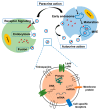The Emerging Roles of Exosomes as EMT Regulators in Cancer
- PMID: 32252322
- PMCID: PMC7226841
- DOI: 10.3390/cells9040861
The Emerging Roles of Exosomes as EMT Regulators in Cancer
Abstract
Epithelial-mesenchymal transition (EMT) causes epithelial cells to lose their polarity and adhesion property, and endows them with migratory and invasive properties to enable them to become mesenchymal stem cells. EMT occurs throughout embryonic development, during wound healing, and in various pathological processes, including tumor progression. Considerable research in the last few decades has revealed that EMT is invariably related to tumor aggressiveness and metastasis. Apart from the interactions between numerous intracellular signaling pathways known to regulate EMT, extracellular modulators in the tumor microenvironment also influence tumor cells to undergo EMT, with extracellular vesicles (EVs) receiving increasing attention as EMT inducers. EVs comprise exosomes and microvesicles that carry proteins, nucleic acids, lipids, and other small molecules to stimulate EMT in cells. Among EVs, exosomes have been investigated in many studies, and their role has been found to be significant with respect to regulating intercellular communications. In this review, we summarize recent studies on exosomes and their cargoes that induce cancer-associated EMT. Furthermore, we describe the possible applications of exosomes as promising therapeutic strategies.
Keywords: Cancer; Epithelial mesenchymal transition; Exosome; Hippo pathway; Wnt/β-catenin pathway.
Conflict of interest statement
The authors declare no conflicts of interest.
Figures



Similar articles
-
Emerging roles of exosomes during epithelial-mesenchymal transition and cancer progression.Semin Cell Dev Biol. 2015 Apr;40:60-71. doi: 10.1016/j.semcdb.2015.02.008. Epub 2015 Feb 23. Semin Cell Dev Biol. 2015. PMID: 25721809 Review.
-
Emerging role of tumor microenvironment derived exosomes in therapeutic resistance and metastasis through epithelial-to-mesenchymal transition.Life Sci. 2021 Sep 1;280:119750. doi: 10.1016/j.lfs.2021.119750. Epub 2021 Jun 23. Life Sci. 2021. PMID: 34171378 Review.
-
Melanoma cell-derived exosomes promote epithelial-mesenchymal transition in primary melanocytes through paracrine/autocrine signaling in the tumor microenvironment.Cancer Lett. 2016 Jul 1;376(2):318-27. doi: 10.1016/j.canlet.2016.03.050. Epub 2016 Apr 7. Cancer Lett. 2016. PMID: 27063098 Free PMC article.
-
Tiny messengers, big Impact: Exosomes driving EMT in oral cancer.Pathol Res Pract. 2025 Apr;268:155873. doi: 10.1016/j.prp.2025.155873. Epub 2025 Feb 27. Pathol Res Pract. 2025. PMID: 40022766 Review.
-
The role of exosomes in the molecular mechanisms of metastasis: Focusing on EMT and cancer stem cells.Life Sci. 2022 Dec 1;310:121103. doi: 10.1016/j.lfs.2022.121103. Epub 2022 Oct 18. Life Sci. 2022. PMID: 36270429 Review.
Cited by
-
Effect of platelet exosomes loaded with doxorubicin as a targeted therapy on triple-negative breast cancer cells.Mol Divers. 2024 Apr;28(2):449-460. doi: 10.1007/s11030-022-10591-6. Epub 2022 Dec 28. Mol Divers. 2024. PMID: 36576666
-
Liquid Biopsy in Diagnosis and Prognosis of Non-Metastatic Prostate Cancer.Biomedicines. 2022 Dec 2;10(12):3115. doi: 10.3390/biomedicines10123115. Biomedicines. 2022. PMID: 36551871 Free PMC article. Review.
-
Role of microRNA/Epithelial-to-Mesenchymal Transition Axis in the Metastasis of Bladder Cancer.Biomolecules. 2020 Aug 7;10(8):1159. doi: 10.3390/biom10081159. Biomolecules. 2020. PMID: 32784711 Free PMC article. Review.
-
Transforming growth factor-β-induced secretion of extracellular vesicles from oral cancer cells evokes endothelial barrier instability via endothelial-mesenchymal transition.Inflamm Regen. 2022 Sep 4;42(1):38. doi: 10.1186/s41232-022-00225-7. Inflamm Regen. 2022. PMID: 36057626 Free PMC article.
-
EMT Participates in the Regulation of Exosomes Secretion and Function in Esophageal Cancer Cells.Technol Cancer Res Treat. 2021 Jan-Dec;20:15330338211033077. doi: 10.1177/15330338211033077. Technol Cancer Res Treat. 2021. PMID: 34278849 Free PMC article.
References
Publication types
MeSH terms
LinkOut - more resources
Full Text Sources
Medical

